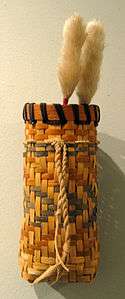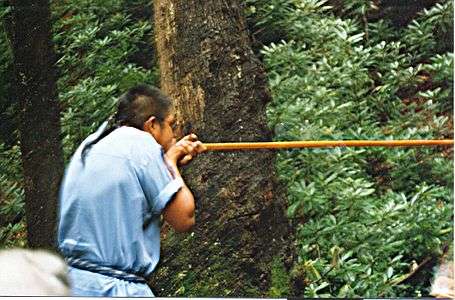Blowgun

A blowgun (also called a blowpipe or blow tube) is a simple weapon consisting of a small tube for firing light projectiles or darts.
The weapon is used by inserting the projectile inside the pipe (known as a blowgun) and using the force created by one's breath to give the projectile momentum. Its propulsive power is limited by the user's respiratory muscles.
History
Many cultures have used this weapon, but various indigenous peoples of Southeast Asia, the Amazon and Guiana regions of South America, and Guatemala in Central America are best known for its use. Projectiles include seeds, clay pellets, and darts. Some cultures dip the tip of the darts in curare or other poisons in order to paralyze the target. Blowguns were very rarely used by these tribes as anti-personnel weapons, but primarily to hunt small game such as monkeys. North American Cherokees were known for making blowguns out of river cane to supplement their diet with rabbits and other small creatures.

Blowguns are depicted in paintings on pre-Columbian pottery and are mentioned in many Mesoamerican myths. Back then and today, the Maya use a blowgun to hunt birds and small animals with spherical dry seeds and clay pellets. The clay ammunition is made slightly larger than needed (to allow for shrinkage and refinement) and stored in a shoulderbag. The outside of the dry clay pellet is shaved off and burnished right before use.[1]
Today blowguns are used with tranquilizer darts to capture wildlife or to stun caged dangerous animals. Herpetologists use blowguns to capture elusive lizards with stun darts. Blowguns are also used recreationally, with either darts or paintballs.
Sport blowgun
There are several competition styles practised around the world. A standardization of competition style, based upon fukiya, is being pursued by the International Fukiyado Association and hopes to become an Olympic event. It is a 10-metre target shooting, using a standardized barrel caliber and length, and a standardized dart length and weight as outlined by IFA.
Two other styles are also being pursued to make up the Olympic blowgun event, both based upon the Cherokee Annual Gathering Blowgun Competition. The Field Style competition is similar to the winter Biathlon, where the shooter runs from a starting line to a target lane, shoots and retrieves the darts, and continues to the next station. The course length varies from 400 to 800 m or longer, with from 9 to 16 targets at various heights and shooting distances. The final style is the Long Distance target shoot. The target is a circle of 24 cm diameter, and the firing line is 20 metres away. Three darts are fired by each shooter, at least one of which must stick in the target. All successful shooters move to the next round, moving back two metres each time.
Sport blowgun competition is managed by the International Fukiyado Association with which national associations in the United States, France, Germany and the Philippines are affiliated.
Gallery
-

Rivercane quiver with blowgun darts, fletched with bull thistle
-

Demonstration of Eastern Cherokee blowgun in Oconaluftee Indian Village, Cherokee, North Carolina
-

A Jakaltek Maya hunter aims at the eye of his target and then blows a clay pellet towards it.
-

Illustration c. 1480 of Medieval Europeans using a blowgun to hunt birds.
Materials
Darts are typically made of hardwoods to prevent cracking, although bamboo skewers can be used informally. The dart's fletch can be made of many materials, such as down, feather tips, and animal fur. Modern materials, such as aluminium or carbon-reinforced plastic, are also used.
In Japan, the competition darts are made of cone shaped cellophane plastic rolled into a cone (Fukiya), topped with a non-pointed brass brad. The Japan Sports Fukiya Association JSFA has privatized the sport, and all materials must be purchased from them. International Fukiya Association IFA chairman H.Higuchi promotes worldwise blowgun rule cooperating with other countries.
In other nations, the use of modified piano wire is used to make the .40 and .50 cal. darts, with certain manufacturers making specialty darts for odd sized or larger caliber barrels (0.35 cal., 0.625 cal., 0.68 cal, and 0.75 cal.)
Use of home-made darts in the larger sizes, or for hunting is common, utilizing bamboo skewers (1/8 in and 1/4 in. diameter), wire coat hangers, and even nails, or knitting needles.
Specifications
As a primitive weapon, there are no set dimension for a blowgun's length and diameter. However, generally there are several sizes:
- Fukidake — diameter is 13 mm (.51 cal) in Japan. Tournament length is 120.0 cm, but for practice one can use a 50 cm tube. No mouthpiece is used; users wrap their lips around the tube. International versions can be slightly more flexible, allowing a tube of 121.92 cm (4 ft) and .50 cal under IFA rules. Darts consist of a paper cone 20 cm long, weighing 0.8 gram.
- Cherokee – made of river cane, six to nine feet long. Dart is 6 to 22 inches long and made of locustwood or other available hardwoods such as oak, ash, maple, walnut, etc., fletched with bull thistle down or rabbit fur, that provides an air seal.[2]
- Jakaltek wooden blowgun averages 1.29 m long with a sight placed 30 cm from the end. Clay pellets are the most common type of ammunition and clay is sometimes added under the sight when the diameter of the blowgun is too thin for more stability and a better aim.
- Modern (US/EU) — typically has a diameter of 10 mm (.40 cal), however, both the 0.50 cal. (12.7 mm) and 0.625 cal. (15.8 mm) are admitted for competitive shooting, with restrictions on barrel length and darts dimensions/weight; with varying lengths having distance restrictions imposed. Bell-shaped mouthpiece. Standard length limited to 121.92 cm (4 feet) in IFA sanctioned competition.
- Paintball marker — made to be identical to the size of a paintball (.68 cal)
Legality
A law was passed in Guatemala in the 1930s outlawing the use of the blowgun in an effort to protect small game. It was difficult to enforce in rural areas, but was one of the reasons for the decline of blowgun use in Guatemala.[3]
In the United Kingdom under the UK 1988 Criminal Justice Act, and in Australia, the blowgun is categorized as an offensive weapon, and as such it is illegal to manufacture, sell or hire or offer for sale or hire, expose or have in one's possession for the purpose of sale or hire, or lend or give to any other person. Antique blowguns are, however, exempt.
In Canada, the blowgun is classified as a prohibited weapon and is defined as any device that "being a tube or pipe designed for the purpose of shooting arrows or darts by the breath".[4] Any imported blowgun must be deactivated by either drilling a hole or by blocking it.
In the US State of California, blowguns are illegal.[5] They are also illegal in Massachusetts and the District of Columbia, but are legal elsewhere. There is currently no age requirement for using a blowgun.[6]
See also
- Fukiya, Japanese blowgun
- Loire-style blowgun (French page)
References
- ↑ Carol Ventura. "The Jakaltek Maya Blowgun in Mythological and Historical Context", in Ancient Mesoamerica 14.2: 257-268, 2003.
- ↑ "Cherokee Games." Archived January 15, 2010, at the Wayback Machine. Cherokee Heritage Center. (retrieved 19 Dec 2009)
- ↑ Edwin Shook. Blowguns in Guatemala. In Notes of Middle American Archaeology and Ethnology, III, no. 67, pp. 37-43. AMS Press, New York, 1946.
- ↑ Department of Justice Canada (1998-12-01). "Part 3. Section 12.". Regulations Prescribing Certain Firearms and other Weapons, Components and Parts of Weapons, Accessories, Cartridge Magazines, Ammunition and Projectiles as Prohibited or Restricted (SOR/98-462). Retrieved 2007-05-29.
- ↑ CA Penal Code §20010 California Legislative Information (retrieved 01 Feb 2016)
- ↑ "Legal and Safety Notices." United States Blowgun Association. (retrieved 19 Dec 2009)
Further reading
- Speck, Frank G. "The Cane BlowGun in Catawba and Southeastern Ethnology" in American Anthropologist 40:2 (Apr.-Jun., 1938), pp. 198–204.
- Sustak, David. 2007. Fukiyado: The Way of the Sport Blowgun. 258 pp.
- Juan F. Marino, Sumpitan - Il Grande Libro della Cerbottana (le origini, la storia, la tecnica, lo sport), Edarc Edizioni, 2007 (only in Italian). 273 pp.
 Chisholm, Hugh, ed. (1911). "Blow-Gun". Encyclopædia Britannica (11th ed.). Cambridge University Press.
Chisholm, Hugh, ed. (1911). "Blow-Gun". Encyclopædia Britannica (11th ed.). Cambridge University Press.- Marinas, Amante P., Sr. 1999. "Pananandata Guide To Sport Blowguns." 110 pp.
External links
- The Blowgun Forum
- Lefora Blowgun Forum
- Deutscher Blasrohr Verein
- France Sarbacane Sport Amateur
- Deutscher Blasrohr Sport Club
- International Fukiyado Association
- Japan Sports Fukiya Association
- United States Blowgun Association
- Cherokee blowgun
- Hunting by more natural methods from The Smoky Mountain News

.jpg)
